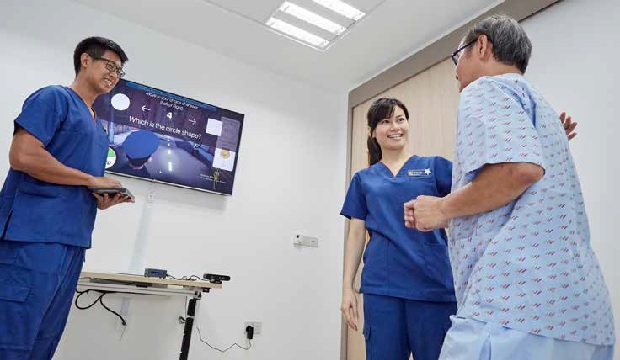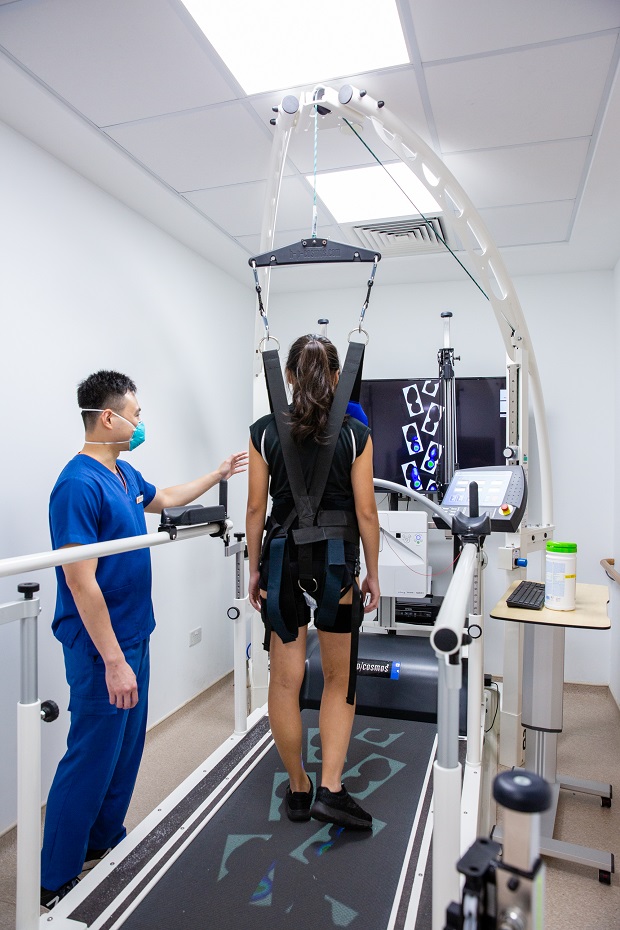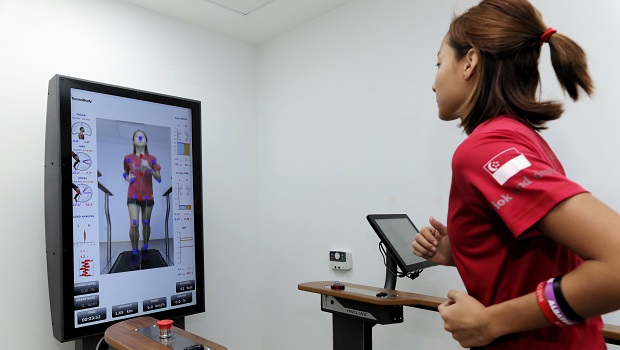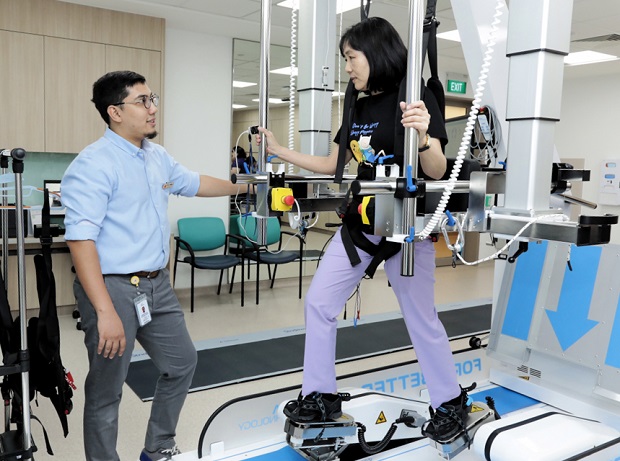Patients can now get better and fitter with the aid of virtual reality, robotic-assisted systems and other smart technologies.
<<Senior Principal Therapist Felicia Seah utilises novel smart equipment to aid in the rehabilitation of her patients.>>
Doing the same set of exercises repeatedly can be tedious and mundane, even for the most motivated fitness enthusiast. For patients who need physical therapy after a stroke, painful injury or debilitating illness, getting them to stay motivated and committed to their rehabilitation programme can be a tough sell.
But what if rehabilitation is carried out in a manner that is interesting, engaging and interactive?
By leveraging novel smart technologies like virtual reality (VR) and gamification, physiotherapists at SingHealth institutions, such as Sengkang General Hospital (SKH), have found new and efficient ways to help patients meet their rehabilitation goals while allowing therapists to monitor their progress and recovery more efficiently.
New developments
The latest high-technology addition to SKH’s outpatient rehabilitation gym is HUR, a brand of senior-friendly smart computerised exercise equipment designed for safe and effective strength and power training.
The majority of patients seen at the outpatient rehabilitation clinic have conditions such as stroke, Parkinson’s disease, vestibular issues, as well as cardiac and pulmonary conditions.

Ms Tay Ee Ling (above right), Senior Principal Physiotherapist, SKH, said the new HUR training equipment is helpful and suitable for patients with these conditions.
Unlike most strengthening equipment that are bilaterally designed (involving two sides), the HUR system (below) allows for unilateral (one-sided) limb strengthening to meet the needs of patient rehabilitation.

"The system also allows physiotherapists to pre-set customised resistance and repetitions for each patient. Patients can access the information on the machine independently to track their progress, reducing the need for assistance or guidance," Ms Tay added.
There are also VR-enhanced treadmills, such as the Walker View (below) and Zebris Gait Training. Using VR simulations and intelligent feedback, patients navigate obstacles and different terrains while improving their mobility, balance, and fitness levels.

"Technological equipment that incorporate VR and gaming, such as Zebris Gait Training, make otherwise mundane rehabilitation activities like walking fun and interactive, thereby increasing patient interest and participation," said Ms Felicia Seah, Senior Principal Physiotherapist, SKH.
Win-win situation
Research has shown that active patient participation and motivation levels influence recovery. In rehabilitation, poor patient participation is linked to longer inpatient rehabilitation stays and poorer outcomes.
That is why patient management has moved from a modality-based approach to an exercise-focused one over time, said Ms Seah.
"For instance, cervical traction and back traction used to be popular treatments for patients with neck and back pain. However, studies show that these modalities are not very effective," she explained.
"With evidence-based practice, physiotherapists have geared towards treatment that involves more active patient participation, such as strengthening and stretching exercises, while ensuring that patients avoid being in certain postures for prolonged periods of time."
In addition, Ms Tay said that the use of technology also allows for early, safe and intensive mobilisation of patients, which may not be feasible when using the traditional rehabilitation approach due to the high manpower demands required.
For example, early gait training is now feasible with the use of robotic-assisted gait training systems, such as the G-EO System (below), for patients with post-stroke conditions, spinal-related injuries, or other neurological conditions. These patients usually require two to three therapists’ assistance to walk, and technological advancements have made this safe and feasible now, said Ms Seah.

Robotic-assisted gait training is a type of physiotherapy technology that applies the principle of focused, repetitive practice to improve mobility. It typically involves the use of a robotic exoskeleton or an end effector (a tool attached to the end of a robotic arm designed to react to stimuli) to help patients train their motor coordination.
Importantly, smart technology is a good add-on to existing rehabilitation techniques, and is beneficial for both patients and therapists — patients are more actively involved and take ownership of their training, while the physical workload of therapists is reduced, enabling them to spend more time engaging with patients and better cater to each individual’s needs.
"Therapists can focus on the patient and treatment in a more precise and targeted way. The rehabilitation intensity of the patient is also not limited to the physical constraints of the assisting therapists, which is a concern in traditional rehabilitation. The use of technology would also result in more consistent training," Ms Tay said.
Patient education is another important factor in rehabilitation, as studies show that patients recover better when physiotherapists spend more time with them.
"Knowledge is key. When patients understand their condition better, they learn to manage it more effectively and are more compliant with their exercises," she added.
Read more: Find out why seniors need to avoid malnourishment during recovery and what to do
The way forward
The SKH team is looking into the use of technology and remote monitoring to support patients at home.
It is currently working on a collaborative research project with SingHealth institutions, including Singapore General Hospital (SGH) and SingHealth Community Hospitals (SCH), to prevent falls among the elderly.
Called SAFE (Steps to Avoid Falls in Elderly) TRIP, this programme is designed for seniors aged over 60 years, and includes the use of digital interventions, such as remote monitoring via home-based games and video conferencing with physiotherapists.
"Although the trial recruitment from SKH, SGH and SCH is still ongoing and we are awaiting the analyses of outcomes, the preliminary results have been promising so far," said Ms Tay, who is the primary investigator for the trial at SKH Campus.
Ms Seah said that under professional guidance, remote monitoring programmes would make it more convenient for patients to carry out their exercises at home. "At the same time, it also drives home the message that self-management is the way to go for successful rehabilitation."
"Technology is becoming more prevalent. However, key components in a patient’s journey, such as human connection and touch, are still integral parts of physiotherapy, and we, as physiotherapists, will be there to journey with the patients through their recovery," Ms Seah said.
Get the latest updates about Singapore Health in your mailbox! Click here to subscribe.
